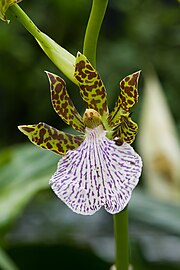Zygopetalum
| Zygopetalum subsp. var. | ||||||||||||||||||||||||||||||||||||||||||||||||||||||||
|---|---|---|---|---|---|---|---|---|---|---|---|---|---|---|---|---|---|---|---|---|---|---|---|---|---|---|---|---|---|---|---|---|---|---|---|---|---|---|---|---|---|---|---|---|---|---|---|---|---|---|---|---|---|---|---|---|

|
|
| ||||||||||||||||||||||||||||||||||||||||||||||||||||||
| ||||||||||||||||||||||||||||||||||||||||||||||||||||||||
Zygopetalum is a genus of the orchid family, consisting of about (40 according to American Horticultural Society / 16 according to Flora) species of medium-sized, evergreen, epiphytic or terrestrial orchids which are natives of humid forests at low- to mid-elevation parts South America, primarily Brazil.
The pseudobulbs are conical to ovoid and produce 2 or more narrowly elongated leaves, shaped like a lance, folded and leathery or fleshy.
Racemes are produced with highly fragrant, waxy, delicate and long-lived flowers, most of which have rich green-brown and indigo-blue colors and come in several patterns. They are erect, about 60 centimeter-long, few-flowered to several-flowered stems that grows laterally longer than the leaves.
They are known for their ease of culture and are much in demand as excellent cut flowers.
Zygopetalums are hardy orchids that enjoy similar conditions to cymbidiums, and are often grown with them.
| Standard Cyclopedia of Horticulture |
|---|
|
Zygopetalum. Orchidaceae. Sepals and petals nearly alike in form and color, often united to each other at the base, the lateral sepals forming a mentum with the foot of the column; labellum with the lateral lobes scarcely prominent, middle lobe broad and plane, spreading, or recurved at the apex, with a prominent fleshy crest on the disk; column incurved, wingless or with small wings; pollinia 4, not appendiculate. The Z. Mackaii group grow well under pot culture. One or two species with creeping rhizomes, like Z. maxillare, thrive best on sections of tree fern, osmunda rhizome, or in baskets. A good compost consists of equal parts of chopped sod, peat-fiber and sphagnum moss, well mixed and interspersed with pieces of rough charcoal, about one-half of the pot space being devoted to clean drainage material. After distributing the roots, the compost should be worked in carefully but not too firmly, about them, leaving the base of the plant even with, or just above, the rim of the pot. Repotting should be done when the plants show new root-action. The temperature should range about 60° F. by night and 65° to 70° by day in winter, and in summer as low as possible, with free ventilation during inclement weather. A cool, light location in the cattleya department is favorable. The compost should be kept in a moist condition at all times. The plants are propagated by cutting through the rhizome between the old pseudobulbs at a good eye, potting up the parts and removing them to a rather higher temperature until they start into new growth. Z. Armstrongiae – Z. Mackaii x Z. rostratum.— Z. Ballii, Rolfe. Fls. white, the sepals purple-tinged, the petals and lip blotched with bright rose-purple. G.C. III. 27:149. G.M. 48:365.—Z. Burtii, Benth.- Huntleya.—Z. chloranthum, Kranzl. Fls. small for the genus, greenish, fragrant, hairy inside.—Z. coeleste, Reichb. f.- Bollea.—Z. discolor, Reichb. f.-Warscewiczella.—Z. Lalindei, Reichb. f.-Bollea.—Z. Patinii, Reichb. f.-Bollea.—Z. Prainianum, Rolfe. Sepals and petals dusky brown, with obscure green stripes on petals; lip white, streaked with rose-purple. Peru. B.M. 8610.—Z. Roeblingianum –Z. rostratum X Z. maxillare. G.C. III. 34:227.—Z. violaceum, Reichb. f.-Bollea.—Z. Wendlandii Reichb. f.-Warscewiczella.
|
Cultivation
Cool to intermediate growing orchids. Grow in standard orchid potting mix, with a lot of coarse bark (epiphytic) in deep containers that can accommodate their vigorous root systems, or in slatted baskets. Provide high humidity and bright light during growth (spring to autumn), while watering freely and fertilizing with orchid fertilizer. Without the humidity/air circulation, leaf tips may dry off and spot. During winter, give it full light and sparing water.
Propagation
Divide when roots fill container and flow over sides. Otherwise, remove backbulbs which you can then pot separately.
Pests and Diseases
Susceptible to spider mites, aphids and mealybugs.
Species
- Zygopetalum brachypetalum Lindl.
- Zygopetalum ghillanyi (Brazil).
- Zygopetalum graminifolium (Brazil).
- Zygopetalum hasslerianum (Paraguay).
- Zygopetalum maculatum Mackay's Zygopetalum (Peru to E. Brazil). type species (formerly *Zygopetalum mackai, Zygopetalum macaii (Hook.) - Epiphytic with fleshy ovoid pseudobulbs and 2 or 3 pendant leaves which are lance shaped, leathery, apical, and 12-20 in. (30-50cm) long. The racemes are upright, with 5-7 green flowers, up to 3in (8cm) across and with bars of brown coloring and a heavily veined indigo-blue lip. Flowers autumn-winter. 12in (30cm) tall, 18in (45cm) wide. Min temp 52-55F (11-13C), Max temp 86F (30C).
- Zygopetalum maxillare : Chin-bone Zygopetalum (Brazil to NE. Argentina)
- Zygopetalum microphytum (SE. Brazil).
- Zygopetalum pabstii (Brazil).
- Zygopetalum pedicellatum Mosen's Zygopetalum (SE. Brazil).
- Zygopetalum Perrenoudii (Z. intermedium x Z. maxillare). Epiphytic with fleshy ovoid pseudobulbs and 2 pendant leaves which are lance shaped, leathery, apical, and 12-20 in. (30-50cm) long. The racemes are upright, with 5-12 green flowers, 2-3in (5-7cm) across and with light bars of brown coloring and a heavily veined indigo-blue lip. Flowers autumn-spring. 12in (30cm) tall and wide. Min temp 52-55F (11-13C), Max temp 86F (30C).
- Zygopetalum reginae (Brazil)
- Zygopetalum rigbyanum (Brazil).
- Zygopetalum sellowii (SE. Brazil).
- Zygopetalum silvanum (Brazil - Bahia).
- Zygopetalum sincoranum (Brazil - Bahia).
- Zygopetalum triste Dark-purple Zygopetalum (Brazil - Minas Gerais) (terrestrial or lithophyte)
Hybrids
Most hybrids heavily influenced by Zygopetalum mackayi, leading to a similarity between many of the crossings. Crossing using Zygopetalum maxillare produced more compact plants, which can bloom more than once per year.
- 'Alan Greatwood' - shapely, round dark brown/maroon flowers with greenish edge to petals and sepals, a white labellum, with dark lilac veining;
- 'Blanchetown' - light tan flowers, purple labellum with darker striping;
- 'Imagination' - dark brown blooms, deep purple labellum;
- 'Kiwi Dust' - green blooms with bars of maroon markings, labellum is white and deep lilac;
- 'Titanic' - robust hybrid, highly fragrant.
References
- American Horticultural Society: A-Z Encyclopedia of Garden Plants, by Christopher Brickell, Judith D. Zuk. 1996. ISBN 0789419432
- Flora: The Gardener's Bible, by Sean Hogan. Global Book Publishing, 2003. ISBN 0881926248
